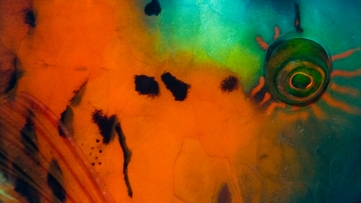
| Home |
| Colors of the Reef |
| Search the Reef |
| Science and the Reef |
| Equipment |
| New |
| Links |
| Contact |
| Interna |
Colors I - Where do all the colors come from?
So, what is light?
Although light can be easily defined by the physics of electromagnetism, to understand how the millions of colors and countless variations of shades and glows our eye can see are generated is a little bit more complicated. Light can be separated by a prism into its components and then described by the terms wavelength (responsible for the color), intensity (or amount of light), and polarization. Some animals, like bees, can “see” polarization and use it for orientation. Humans can not if not using a polarizing filter in front of their cameras. I will not discuss polarization here, although I am not sure if it is of importance for some of the creatures in the oceans. The “visible” light extends from a wavelength of approximately 400 nm (blue) to 800 nm (red), at shorter wavelengths we find ultraviolet light and at larger wavelengths infrared. Ultraviolet and infrared we can’t see, but some animals can, at least to some extend.

Spectrum of “visible” light from blue (400 nm) to red (800 nm) (Source: Wikipedia)
At this point we note that visible light can be described by two variables, the wavelength, which is any number between 400 nm and 800 nm, and the intensity, which is any number between zero (no light of this wavelength) and infinite (we have to define a unit for the intensity). And, of course, we can have an infinite mixture of light of a certain wavelength and intensity, which means we go from monochromatic to polychromatic light. If we plot the wavelength against intensity we obtain a spectrum, which is the best way to visualize the composition of light. However, to our eye, all this is only one color, no matter of it physically is monochromatic or polychromatic.

